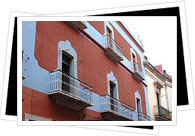
One of Guanajuato's most enchanting highlights, along with one of the reasons for designation as a UNESCO World Heritage City, is its impeccable colonial architecture. The surge of wealth during the Spanish colonial epoch after tapping one of the world's richest silver veins not only filled silver barons' pockets but also sparked a construction craze that provided Guanajuato with the elegant mansions, handsome churches and fine plazas that continue to beautify the cityscape today.
During the 300 years of Spanish rule, Mexico's towns and cities were constructed from the ground up following the trajectory of Spanish architecture: Gothic, Renaissance, Baroque and Neoclassical. However, local influences and variations like the signature pastel-colored stucco and pale pink stone infused the predominantly Spanish architecture with a markedly regional flare.
Guanajuato's silver-mining capacity was discovered in 1558, and the town began to prosper almost immediately- just in time for the tail-end of the Renaissance and beginning of the Baroque.
As a cultural, artistic and architectural movement, the Renaissance drew from the Roman and Greek ideals of discipline, proportion and harmony. Classical shapes - squares, circles, triangles - were incorporated, as were elements such as the column. The Renaissance in Mexico tended to manifest itself in the form of Plateresque, a branch of the Renaissance that was so-named because it was thought to resemble decorative silverwork ("platero" = silversmith). Essentially using the Renaissance concepts but with a more ornamental flare, Plateresque is known for the sculpted stone of its façades and doorways.
Come early 17th century, Guanajuato - along with the rest of Mexico - eased into the Baroque architectural style, which incorporated elements like curves, contrasts of light and shadow, color and elaborate decoration for a more dramatic impact. The integration of sculpture and painting into the architecture was key, which can be seen in the many ornate and often colossal altarpieces ("retablos").
Churrigueresque, a specific manifestation of Baroque, peaked in Mexico between 1730 and 1780. Constructions dating back to that 50-year span boast spectacularly ornate and even over-the-top decoration. In Guanajuato, you can check out three quintessential examples in the churches of San Francisco, La Compañía de Jesús and La Valenciana.
The dawn of the Neoclassical epoch brought with it another return to the simplicity, harmony and sobriety of early Greek and Roman civilizations. The city's best example is without a doubt the Alhóndiga de Granaditas.